
History of Early Manti, Utah
Part of the story of the early settlement of Manti, Utah with Edwin Whiting is told by Mary E. Cox Whiting. Theirs was a struggle for survival, much like the many other Pioneer settlements of the area. Edwin’s participation in the Agricultural and Mining, his term in the Legislature, are told elsewhere on this website.
After the Saints were driven out of Nauvoo in 1846, they settled at Mt. Pisgah for two years and then made the long trip to Utah. After resting up for a few days in Salt Lake City, they went with Father Isaac Morley to the Sanpitch country, now Sanpete County, which later became the City of Manti, the first settlement in this area.
They arrived in Sanpete on the first of December, 1849. This was to be the Whiting home for the next 12 years, except for the two years, when Edwin was a missionary to Ohio. In the meantime, there were the distractions of the Indians and the short growing seasons to deal with.
These photographs are a history of Edwin’s Manti, both before and after his mission and his subsequent move to Springville.

Reproduction of the Dug Outs
The Story of the Manti Dugouts 1849- 1850
In June of 1849, Chief Walker, with a band of Ute Indians visited President Brigham Young. He asked that the colonizers be sent to Sanpitch Valley, which was named after the Indian Chief Sanpitch, a brother of Chief Walker. They wished to be taught how to till the soil and build homes. Brigham Young sent an exploring party with Chief Walker as their guide, consisting of Joseph Horn, W. W. Phelps, Ira Willes and D. B. Huntington. They entered the beautiful Sanpitch Valley, crossing the divide from Salt Creek Canyon and reached the present site of Manti on August 20, 1849. After remaining a few days, the party returned to Salt Lake and reported favorable conditions for a settlement.
A group of two hundred twenty-four settlers, consisting of fifty families were led by Isaac Morley, president of the company. They left Salt Lake City and drove their wagons and stock 125 miles and camped just west of what is now known as Temple Hill.
Among the original pioneers were the following men, some accompanied by their families: Seth Taft, Charles Shumway, D. B. Huntington, Barney Ward, John Lowry, Sr. Titus Billings, G. W. Bradley, Albert Petty, O. S. Cox, Albert Smith, Jezreel Shoemaker, Cyrenus H. Taylor, Azariah Smith, Abram Washburn, John D. Chase, Isaac Chase, Sylvester Hulet, William Potter, Gardner Potter, James Brown, Joseph Allen, M. D. Hamilton, William Richey, Harrison Fugate, Sylvester Wil~ox, Gad Yale, John Carter, Isaac Behunin, William Mendanhall, Edwin Whiting, William Tubbs, Jolm Hart, John Baker, John Elmer, John Butterfield, Amos Gustin, John Cable, and W. K. Smith.
These pioneers came through Salt Creek Canyon, which is the pass east of Nephi. They cleared roads, forded streams, built bridges, and arrived at their destination on about Nov. 22, 1849. They hoped to build temporary shelters before winter set in. They made camp just before a heavy storm arose, and within a few days it left the valley blanketed with three feet or more of snow. Their wagons afforded scant protection against the wind and freezing temperatures which followed. Desperately in search of better shelter, the settlers turned to the hill where the Manti LDS Temple now stands. Preparations to build temporary homes began immediately. The homes were dugouts which were made by digging a hole into the side of the hill. Trees were felled along the creek and dragged to the hill to complete a home. One log was placed at the back to the room against the hill as a back support for the roof. A sufficient number of logs were placed on the sides of the room to square the sides, and the front was made entirely of logs. A door was placed at the front of the room. The roof was made with a foundation of poles which were then covered with trees and brush, and all was finally covered with a generous supply of dirt. Each room contained a fireplace. Some were dug into the hill with a chimney leading up the back of the roof, others were built on the front side of the room. A quilt or a piece of wagon cover served as a door to keep out the chilling blast of winter. The logs were chinked with mud to make them tight. The homes though crude, provided more protection than the wagons and were much appreciated. That first winter no meetings were held except for family worship in the homes. No schools were held except the lessons taught by fireside. No communications were received from the outside world. They trusted in their God for protection in this new environment. In Spring, when the snow began to melt, and the days became warm, the peaceful settlement was interrupted with the continuous hissing of rattlesnakes. They were found to exist everywhere though out the homes of the settlers, on boxes, buckboards, beds, etc. A vigorous fight was inaugurated and hundreds were killed in one night. There is no record of any of the saints being bitten.
This monument and pioneer dugout replica, honor the founders of Manti and Sanpete County who endured the harsh winter of 1849. The dugout symbolizes their humility, faith, obedience and willingness to sacrifice all for building up the Kingdom of God. From their meager beginnings in humble dugouts to this glorious temple on the hill and communities throughout Sanpete County, these visionary saints worked to help establish “Zion” in the Rocky Mountains. Inspired by their fervent testimonies of the restored Gospel of Jesus Christ, these industrious pioneers made “the desert rejoice and blossom as the rose.” (Isaiah 35: 1)
The dugout was built by Manti Utah Stake Young Men and Young Women and was dedicated on November 21,1999.
Source: A small pamphlet provided at the Site of the Dugout’s.
It is known that some of the first settlers lived in the dugouts in the South side of the mountain near where the temple now sits. A modern day reproduction of the Dugouts where the residents lived in that first winter is pictured here. Three of Edwin’s children were among those born that first winter in the dugouts. This reproduction is located on the street just south of the Manti Temple and may be seen by going east three blocks. It is located back in a short little street to the side of the Temple Hill. During the summer Manti Pageant weeks, the dugout is usually open with guides. At other times, it can be visited by asking for a key at many of the motels or eating establishments in town.
Orv Shares His Supper
by Phrasia Cox (Euphrasia Cox Day)
When Manti was first settled in 1849, Orvill S and Elvira P. Cox were the first settlers. He built a dugout log cabin in the south side of what is now Temple Hill and made his family, wife and three children, fairly comfortable for those times.In the spring of 1850, when the weather was pleasant, the mother formed the habit of setting Orville Jr., two and a half years old, on the stone doorstep and giving him a cup of bread and milk for his supper.
*This story happened in the house next to my grandfathers home in Manti and they were relatives.
Source: Marie J. Whiting Collection, typewritten page.
Manti’s First and Second Ordinance:
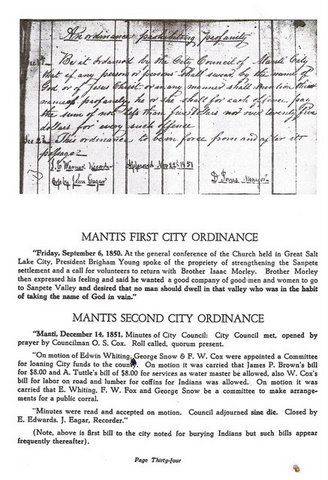
Edwin Whiting participated in the early Planning of the City of Manti. The first City Ordinance of Manti was the prohibition against swearing. The second ordinance shows Edwin Whiting’s participation in this meetng.
As they were able, they built a fort and moved inside for their safety. The Map shows both the Little Fort and the Big Fort.
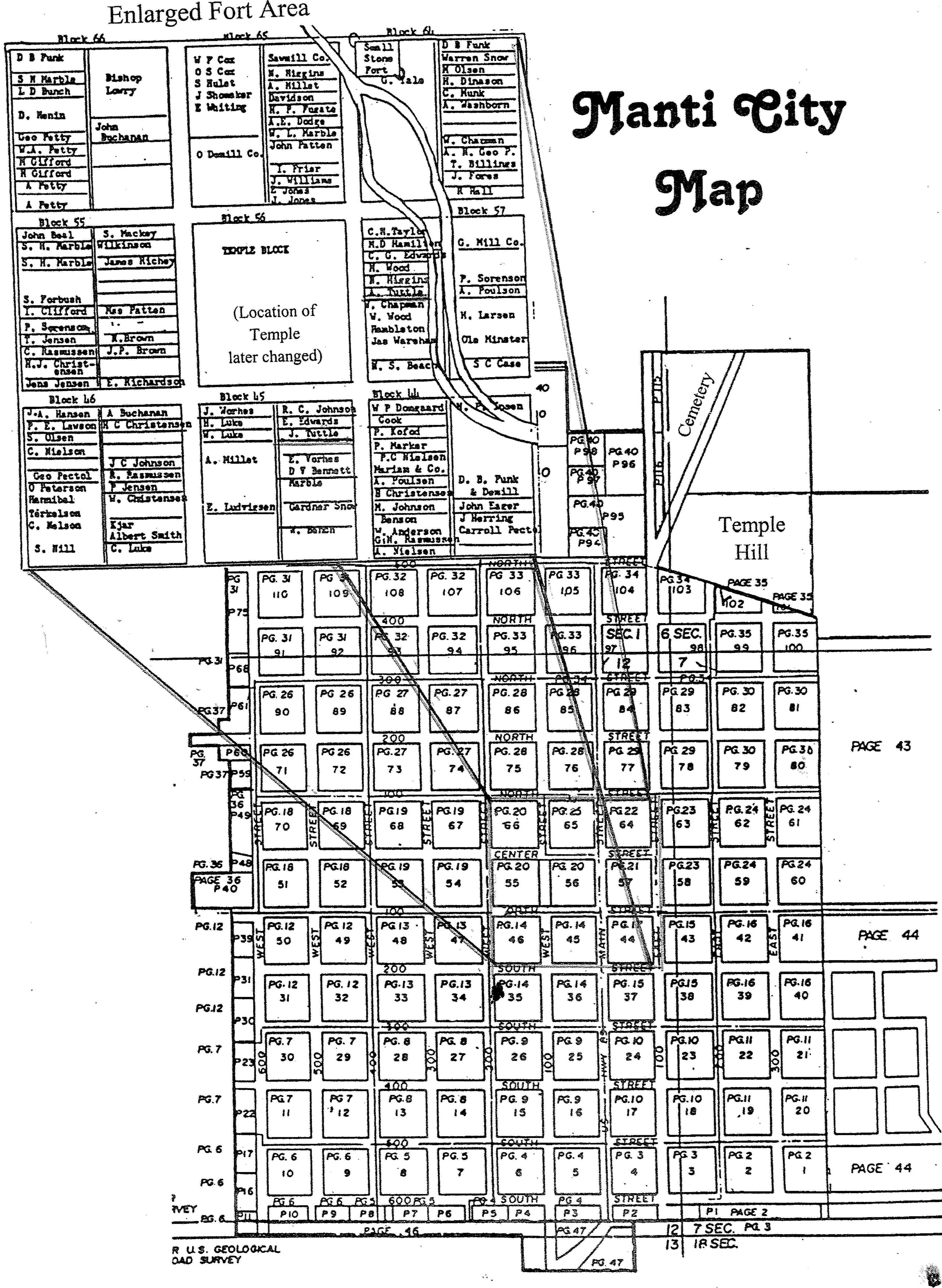
The Little Fort and the Big Fort
These images show the location of the Little Fort, built first, extended above the Big Fort built later. The enlarged portion of the Little Fort shows the names an location of families within the Fort. A close look at Block 65 shows the location of Edwin whiting and a couple Cox families. See if you can locate Abram Washburn, Father of Mary Ann Washburn, and Elisha Edwards, Edwin’s missionary companion.
A Newspaper Article about the Mayors of Manti

The book, Before and After Mt. Pisgah, by Clare B. Christensen, contains a map of Manti showing the location of the later homes of some of the early settlers after they had moved out of the fort. Edwin Whiting’s home was on the corner of 100 West and 400 North, facing West. It must have been built some time between his return from from his Mission in 1856 and his move to Springville in 1861. These must have been busy years for him, trying to get his fruit trees started and his political activity. The dates of the following series of photographs of his Manti property are uncertain, but they were taken after his property had been abandoned. One photograph that survives is dated as late as 1963.
One of the long time settlers in Manti, Clarence Whiting, is credited with taking interested family members to see the home of Edwin Whiting and had measured the size of the various rooms. His measurements of this old home survive, but are not complete enough to translate into a floor plan.
Following are photos of some of the Manti property of Edwin Whiting. They had been abandoned by the time these color photos were taken.
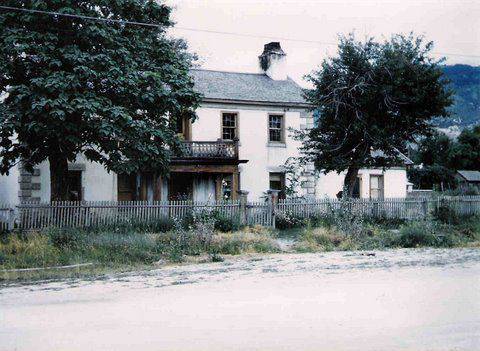
Edwin Whiting Home facing West on 100 West and 400 North
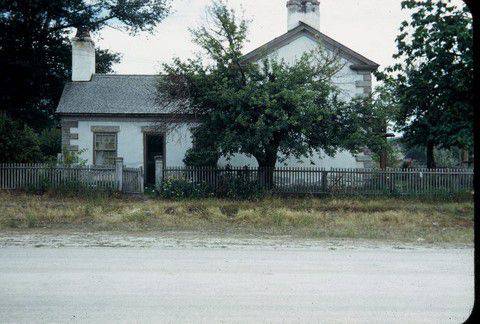
The Edwin Whiting Home. This photograph shows the north side of the home, which faced 400 North at the corner of 100 East.

Edwin Whiting Granary – Manti, Utah
Source: Articles and Images from Marie Olsen, Manti, Utah and from the Marie J. Whiting Collection
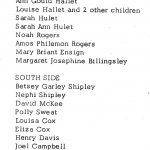
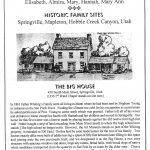
No comment yet, add your voice below!